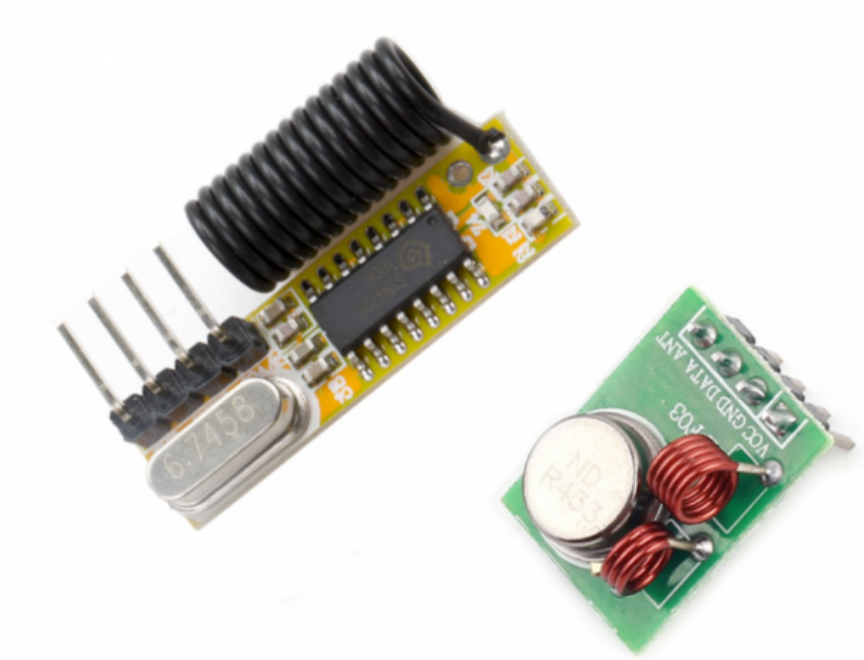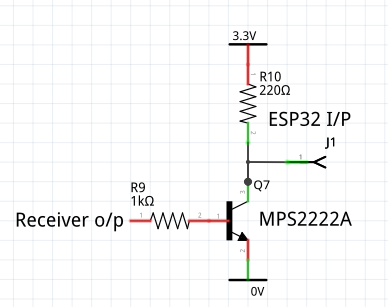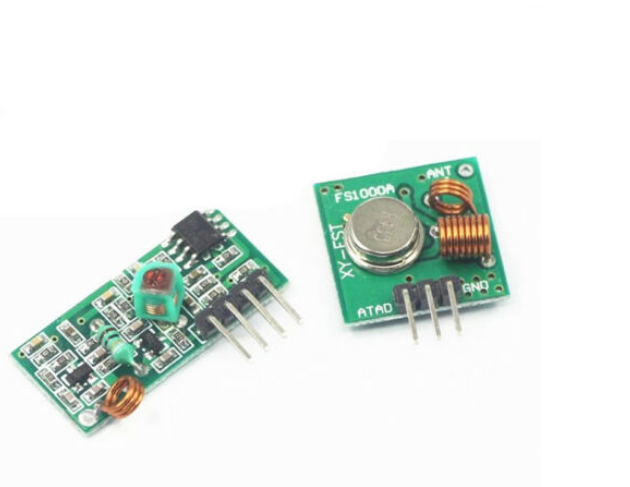Remote controlled wall sockets provide a convenient way to control power to electrical equipment.
They are cheap, reliable and consume negligible power. However they lack flexibility: they can only be controlled by the matching remote. This library provides a means of incorporating them into an IOT (internet of things) solution, or building a remote capable of controlling more devices with a better antenna and longer range than the stock item.
For the constructor a key benefit is that no high voltage wiring is required.
The approach relies on the fact that most units use a common frequency of 433.92MHz. Transmitter and receiver modules are available for this frequency at low cost, e.g. from Seeed. The Seeed units:
I also tried one from eBay. This worked, but the receiver had poor sensitivity requiring the remote to be held very close to it to achieve results.
The signal from the supplied remote is captured by a simple utility and stored in a file. Multiple signals - optionally from multiple remotes - may be stored in a file. The utility is used interactively at the REPL. Supported targets are Pyboard D, Pyboard 1.x, Pyboard Lite, ESP32 and Raspberry Pi Pico.
This module is intended to be used by applications. The application loads the
file created by the receiver and transmits captured codes on demand.
Transmission is nonblocking. Supported targets are Pyboard D, Pyboard 1.x,
ESP32 and Raspberry Pi Pico. Pyboard Lite works in my testing, but only in
blocking mode. The module does not use uasyncio but is compatible with it.
It should be noted that this is for experimenters. The capture process cannot be guaranteed to work for all possible remotes and all radio receivers, not least because the timing requirements are quite stringent. The receivers I own introduce significant jitter. The library uses averaging over multiple frames to improve accuracy.
See section 6 for the reasons for this approach.
Early firmware has this issue affecting USB communication with some PC's. This has been fixed: please use firmware V1.16 or later.
A breaking change was introduced to the firmware in July 2021 affecting the transmitter. The code has been adapted to accommodate this: in consequence firmware more recent than this must now be used (a daily build, until the release of V1.17).
Receiver: copy the rx directory and contents to the target's filesystem.
Transmitter: copy the tx directory and contents to the target's filesystem.
In each directory there is a file get_pin.py. This provides a convenient way
to instantiate a Pin on Pyboard, ESP32 or Raspberry Pi Pico. This may be
modified for your own needs or ignored and replaced with your own code.
There are no dependencies.
It is difficult to generalise as there are multiple sources for 433MHz transceivers. Check the data for your modules.
My transmitter and receiver need a 5V supply. The receiver produces a 0-5V signal: this is compatible with Pyboards but the ESP32 and Raspberry Pi Pico require a circuit to ensure 0-3.3V levels. The receiver code is polarity agnostic so an inverting buffer as shown below will suffice.
Receiver defaults are pin X3 on Pyboard, pin 27 on ESP32 and pin 17 on Pico, but any pins may be used.
The transmitter can be directly connected as 5V devices are normally compatible with 3.3V logic levels. Transmitter defaults are X3 on Pyboard, 23 on ESP32 and 16 on the Pico. Any pins may be substituted. The data for the Seeed transmitter states that a supply of up to 12V may be used to increase power. Whether this applies to other versions is moot: try at your own risk. I haven't. All the remotes I've seen use a miniature 12V battery. This may (or may not) mean that a 12V supply is commonplace on transmitter modules.
Pyboards: Timer 5.
ESP32: RMT channel 0.
Pico: PIO state machine 0, IRQ 0, PIO 0.
The Pico uses tx/rp2_rmt.py which uses the PIO for nonblocking modulation in
a similar way to the ESP32 RMT device. To use this library there is no need to
study the code, but documentation is available
here for
those interested.
The RX class behaves similarly to a dictionary, with individual captures
indexed by arbitrary strings. An RX instance is created with
from rx import RX
from rx.get_pin import pin
recv = RX(pin())To capture a pin on a remote and associate it with the key "on", the remote should be placed close to the receiver and the button held down. Then issue
recv('on')If the capture is successful, diagnostic information will be output. If capture fails with an error message, repeat the process with the same key string. It is important that the button is pressed before issuing the above line, and only released when the REPL reappears.
To capture further buttons, repeat the procedure with a unique key for each button.
When this is complete, the dictionary can be saved as a JSON file (in this example called "remotes") with:
recv.save('remotes')Examples assume an RX instance recv; key is a string used as a dictionary
key.
Constructor args:
pinAPininstance initialised as input.nedges=800The number of transitions acquired in a capture. Larger values may provide better accuracy at the cost of RAM use.
Methods:
load(fname)Load an existing JSON file.save(fname)Save the current set of captures to a JSON file.__call__(key)Start a capture using the passed (string) key:recv('TV on').__delitem__(key)Delete a key:del recv['TV on'].__getitem__(key)Return a list of pulse durations (in μs):lst = recv['TV on'].show(key)As above but in more human readable form.keys()List the keys.
These are intended to provide some feedback on the likely success of a capture. The acid test is, of course, to transmit it. A successful capture will produce output similar to this:
Frame length = 50 No. of frames = 14
Averaging 14 frames
Capture quality 34.3 (perfect = 0)
This shows that each frame comprises 50 edges (25 "mark" pulses). The capture process acquired 14 complete frames. In this instance all frames were of the same length so none were discarded. Averaging was done on all of them to yield accurate timing information.
On occasion the diagnostics will report discarding frames of the wrong length: if only one or two are discarded the capture will probably be successful.
The "Capture quality" is a measure of the standard deviation of the timing of the frames; a perfect capture would produce a value of zero. Its purpose is to help with placement of the remote near to the receiver. There is no particular "fail" threshold: I have had successful captures with values >60. A value around 15 is good.
Assuming the JSON file "remotes" is on the target's filesystem, and it contains a button capture with the key "TV on":
from tx import TX
from tx.get_pin import pin
transmit = TX(pin(), 'remotes')
transmit('TV on') # Immediate returnThe transmit method is nonblocking, on Pyboard, ESP32 and Raspberry Pi Pico. There is an alternative blocking method for use on Pyboard only. This offers more precise timing, and I found it necessary on the Pyboard Lite only. This is accessed as:
transmit.send('TV on') # BlocksThe capture process stores data with a resolution of +-1μs (absolute accuracy is less, as discussed above). The ESP32 uses the RMT class and the Pico uses a PIO library: both these solutions produce pulses whose lengths match the data value +-1μs. To put this in context, the shortest pulse I have measured from a remote is 110μs.
Examples assume a TX instance tx; key is a string used as a dictionary
key.
Constructor args:
pinAPininstance initialised as output, withvalue=0.fnameFilename containing the captures.reps=5On transmit, the captured pulse train is repeatedrepstimes.
Methods:
__call__(key)Normal nonblocking transmit:tx('TV on'). Blocks for ~2.2ms on Pyboard 1.1, 980μs on ESP32. Transmission continues as a background process.send(key)Blocking transmit. For more precise timing on Pyboard only.__getitem__(key)Return a list of pulse durations:lst = tx['TV on']. Values are μs.show(key)As above but in more human readable form.keys()List the keys.latency()Returns a time in ms calculated from the capture file. It is the recommended minimum length of time which should elapse between successive nonblocking transmissions. The value is conservative. Switching wall sockets is subject to unknown amounts of latency in the sockets and in the powered devices themselves: it is not capable of millisecond-level precision.
Class method:
active_low()Match a transmitter which transmits on a logic 0 (if such things exist). Pyboard only. Call before transmitting data. In this case thePinpassed to the constructor should be initialised withvalue=1.
On ESP32 and Raspberry Pi Pico if an active low signal is required an external inverter must be used.
The value of the reps constructor arg may need to be increased for some types
of socket or in cases where radio interference is present. If your captures are
not received, try a value of 10. Larger values increase RAM use (on ESP32, not
on Raspberry Pi Pico). They improve the probability of successful reception.
The
rc-switch library uses a value of 10.
This assumes that the new uasyncio will acquire a Queue class. Other tasks
place keys onto the queue, send_queued() transmits them ensuring that the
latency limit is met.
import uasyncio as asyncio
from tx import TX
from tx.get_pin import pin
txq = asyncio.Queue() # Other tasks put data onto queue.
async def send_queued():
transmit = TX(pin(), 'remotes')
delay = transmit.latency() # Only need to calculate this once
while True:
to_send = await txq.get()
transmit(to_send)
await asyncio.sleep_ms(delay)In the continued absence of an official Queue class, an unofficial version is
available, documented
here.
The RX class enables maintenance of the JSON file: it is possible to add new
captures and overwrite or delete existing ones.
Load an existing file, add a new capture, and update the file. The same procedure might be used to replace a capture which had failed to work:
from rx import RX
from rx.get_pin import pin
recv = RX(pin())
recv.load('remotes') # Load file, start remote transmitting, then issue:
recv('TV on') # With remote continuously transmitting
recv.save('remotes') # Save file to same namefrom rx import RX
from rx.get_pin import pin
recv = RX(pin())
recv.load('remotes') # Load file
del recv['TV on']
recv.save('remotes') # Save file to same nameData is stored as a series of pulse lengths in μs. These may be printed out.
from rx import RX
from rx.get_pin import pin
recv = RX(pin())
recv.load('remotes') # Load file
recv.show('TV on') # Access captureThe default state of the transmitter is not transmitting, so the first entry (#0) represents carrier on (mark). Consequently even numbered entries are marks and odd numbers are spaces. Captured frames have an even number of entries. This ensures that the carrier is off between sequences. Leaving it on is an invalid use of the 433MHz band. If creating sequences in code, this should be honoured.
If the capture process reports success, the problem is likely to be with the transmitter.
Try running the receiver, connected to a scop or logic analyser while operating the transmitter to see if pulses are being received. Alternatively run the receiver utility on another MicroPython device. Try first with the remote and then using the transmitter. If they are detected you can be confident of the transmitter hardware.
On any target increase the reps constructor arg to 10 and possibly beyond.
On the Pyboard try the blocking send method. I found this necessary on the
Pyboard Lite: it offers better timing. ESP32 and Raspberry Pi Pico timing are
highly accurate for reasons discussed above.
My house is littered with remote controlled mains sockets. These are usually located in hard to reach places, behind computers or other kit, and are controlled by tiny 433MHz remote controls. They have two limitations:
- Range. This can be down to two metres. With decent antennas 433MHz band devices can communicate over 100M or more. The problem results from small antennas and difficult receiver locations.
- Flexibility. Sockets can only be controlled by the bundled remote.
For some time I've been considering ways to control mains devices with greater range, ideally from the internet, but all had drawbacks. These 433MHz sockets have the benefits of being utterly reliable with power consumption too low for me to measure (<0.5W). A means of transmitting to them from a MicroPython target would present a wide range of control options.
This was inspired by a forum post by Kevin Köck. Having posted my IR library it struck me that there was a lot of commonality. In each case we generate and receive OOK (on-off keying) messages. In the case of 433MHz the conversion between modulation and carrier is done by external hardware. A cheap 433MHz transmitter, driven by a Pyboard D or ESP32, might provide a solution with network connectivity.
Depending on range, these could be deployed in two ways:
- A single, centrally located, TX with a good antenna and groundplane might serve all sockets in a house.
- Failing that, several transmitters could be located near their respective sockets.
There seems to be one measure of standardisation between these devices: the RF carrier frequency of 433.92MHz. There are two potential ways of approaching the problem, both of which work with IR transceivers.
This has been done in rc-switch, a C library for Arduino and the Raspberry Pi. It supports 12 protocols: it seems evident that there is much less standardisation than in the IR arena where a few well-documented protocols find wide use. In many IR applications the programmer can choose the protocol and buy a remote which supports it. This luxury isn't available to someone with a pre-existing set of switched sockets.
Advantages:
- Efficient applications can be written: each remote key can be represented by a single integer or string, being the data to transmit.
- There is no need for data capture and hence no need for a receiver.
- Transmit timing based on protocol knowledge is as accurate as possible.
Drawbacks:
- Some protocols use weird concepts such as tri-bits. The set of N-bit binary numbers representing transmit data contains invalid bit patterns.
- It's hard to do because of the multitude of protocols. The Arduino library is quite big.
- Porting is problematic: an example of all 12 types of socket would be required and I believe many are for US 115V power.
This reference describes some of the issues.
This involves setting up a receiver, pressing a key on the remote, and storing the received pulse train for subsequent playback, typically on a different device.
With IR protocols this is problematic. Protocols have radically different ways to deal with the case where a key is held down. Radio protocols repeatedly send the same code, greatly simplifying capture.
Advantages:
- It is protocol-agnostic so should work on any set of sockets.
- The code is simple and easily tested.
Drawbacks:
- It requires a receiver to perform the initial capture.
- It needs a fairly fast and capable target because timing is critical.
- It is relatively inefficient: every key will be represented by a list of N integers, being the on or off duration in μs. In practice N is typically 50; data volume is hardly excessive.
- There is some loss of timing precision as the capture process introduces uncertainty.
Note that once the capture task is complete the receiver and target can be re-purposed. Receivers are cheap and are usually bundled with transmitters.
The modulation is quite fast with pulse durations down to values on the order of 100μs. Successful capture depends on the quality of the receiver. The Seeed one had much better sensitivity than this one, bought on eBay:
With this receiver, even with the remote very close to the receiver, there was jitter in the output pulse train. This was sufficient to prevent successful transmission. Attaching an antenna made no discernible difference.
Because of these problems the code captures a few frames and performs averaging. The eBay one worked, but I recommend the Seeed one which produced better diagnostic information without having to place the remote centimetres from the receiver.
In response to requests I have provided example_file as an instance of the
file format in use. It is a JSON encoded dict. The key is a string defining
the button name. The example has keys "on" and "off". The value is a list of
times in μs. The first is a transmitter ON time, followed by an OFF time,
continuing to the end of the list.



